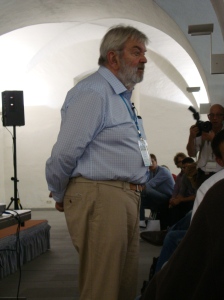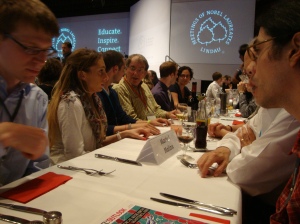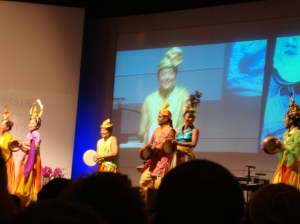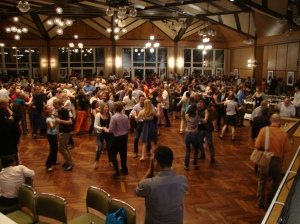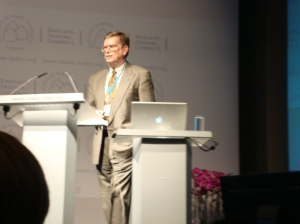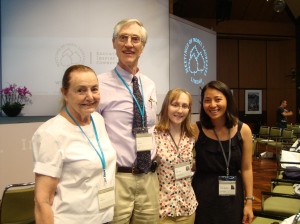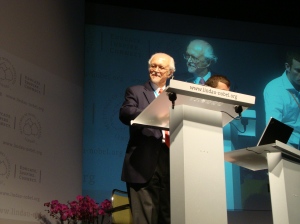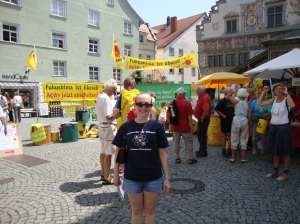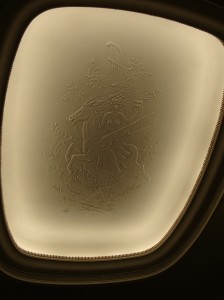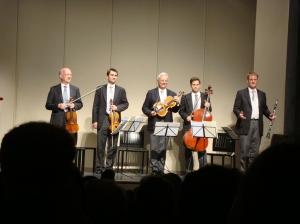In the afternoon each day at the Lindau Meeting, the Laureates who gave presentations that morning each had a discussion section, and students were free to attend any of them. The Nature team had asked Vicky and I to try to avoid discussing energy issues with Dr. Molina or Dr. Rubia before the filming Wednesday to make sure our discussion was fresh. I was somewhat tempted to attend Dr. Giaever’s discussion and see if students would ask him hard questions. But I also thought his section would probably have a ton of people and maybe I didn’t want to encourage him by attending.
I decided to go to Dr. Smoot’s discussion; it was a good choice. I must have been right that some of the other sections were huge because less than 15 people were at Dr. Smoot’s. Now maybe from Dr. Smoot’s perspective he would have liked to have more students interested in his talk, but from my perspective it was awesome to have a small group. I got to ask several questions and feel like I really got to interact with him.
My first question to Dr. Smoot was a technical one dealing with why the composition of the universe changes over time. He gave a good answer that made me understand the concept, but to type it out here with enought background to make it clear what I was even asking about would take way too long. If you’re really interested in the technical work that Dr. Smoot does, listen to his talk from the morning session (and you could also listen to Dr. Schmidt’s talk for more technical detail on a similar topic). I’ll focus my account here on the nontechnical part of the discussion and try to convey a bit of Dr. Smoot’s personality.
I take furious notes and try to write everything I hear as accurately as possible, but still I must shorten and paraphrase things. In writing Dr. Smoot’s answers to some questions here I do my best, but any mistakes or misrepresentations are my own unintentional fault.
My question: When you were doing the work that led to your Nobel Prize, did you realize at the time how important it was?
Dr. Smoot’s paraphrased answer: Science is timely. You should pick a problem to work on that is important and can completed in around 5 years. Just because you are the only person in the world that can make a measurement, what you’re doing is not necessarily important. While you’re spending years and years on the experiment for that special measurement, science will flow around you and find another way. I can think of many important problems, for example quantum gravity, but after 30 years the people working on it are still doing the same thing.
One of my mentors had a design for a new experiment, but told me to take a break and see if there is already a method available that could be applied to this problem instead of taking the time to build a new experiment. So I read a lot and got some good ideas. I picked working on the cosmic microwave background (CMB) because I thought it was important, it was doable, and if you’re going to look at the early universe you will surely find something important, and it was likely that more discoveries would follow in this area.
My summary: No, he was not thinking of winning the Nobel Prize when he decided to work on the CMB project, but he picked that project specifically because it seemed like it could be completed in a few years and would likely give important information about the early universe. He encouraged us students to select our research projects carefully too.
My question: Is there something else you’re interested in? Another area of science that you would investigate if time was not an issue?
Dr. Smoot’s paraphrased answer: There are several Laureates who switched to research where the end use is really important rather than just basic understanding. The previous generation had the cold war going on and people were grateful to science for developing atomic bombs, radar, etc and this made science funded very well. When I started there was more freedom to research a new area. After the cold war, science funding began to go down. This is a problem for CERN and future machines. Now it is even more important to have good reasoning for your research.
There are three categories of research:
1. Pure research-where you just solve physics problems and don’t have much economic impact. For example Einstein.
2. Applied-Think of Thomas Edison who had tremendous economic impact
3. In between-research that can be used directly. I support this a lot, where there is interesting basic research but the end use is clear and advantageous. For example, my colleague Steven Chu received a Nobel Prize for atomic beams, but then moved his research into biofuels because he thought it was such an important topic for the world. He created different divisions like climate and also had a focus on industry and commercializing.
Certain countries are still supporting all kinds of scientific research. For example, Singapore decided to invest heavily in science with 3-5% of its GDP whereas most countries only invest more like 0.5%
Another student’s question: Can you talk about when you were on the show “The Big Bang Theory”?
Dr. Smoot’s paraphrased answer: I thought it was a good show that showed scientists in a semi-ok way, not just in lab coats. Early on the goal of the show was to make fun of nerds and non-nerds and show how each group could be funny or normal. Now the focus seems to have shifted to more focus on making fun of the nerds. I had my secretary contact them and see if they would be interested in me being on the show and they were. It was interesting and fun being on the set. The actor that plays Sheldon is not a science person at all in reality, but does a really good job of memorizing all the technical things required. Since I was in the episode I’m in the Screen Actor’s Guild. Every time my episode is played I would get a check for around $76 but the SAG takes about $30 so I’m only left with $46.
When it was about the end of the scheduled time for the discussion Dr. Smoot got to talking about some really interesting topics like the holographic principle for black holes, the future not existing, space not being continuously 3-D, and what might have happened before the Big Bang. He talked for at least 15 min after the supposed end time and I think would have kept going except for the reminders from the Lindau staff person that was there to escort him to his next event. Despite the staffer trying to herd him away, Dr. Smoot was kind to all us students and stayed even longer to do some photos and autographs. I was lucky enough to snag an individual photo with him.

